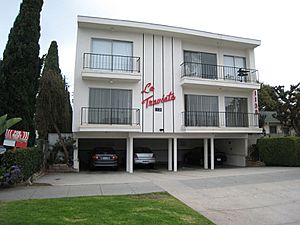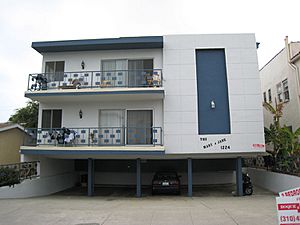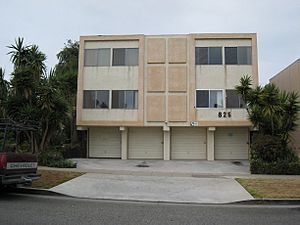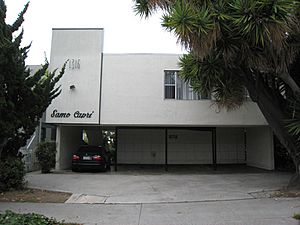Dingbat (building) facts for kids
A dingbat is a special kind of apartment building. These buildings became very popular in parts of the United States like Southern California during the 1950s and 1960s. They are usually two or three stories tall and look like a simple box. A key feature is that they have parking spaces tucked underneath the building, often right at the front.
Dingbats are still common today. They offer homes that are often more affordable to rent. While they are mostly found in Southern California, you can also see them in places like Arizona, Florida, Hawaii, Nevada, and Vancouver. Some people think dingbats are not very pretty. But others find them interesting examples of Mid-Century modern design. Many dingbats even have fun names and unique decorations!
From an engineering point of view, the parking area under the building can be a weak spot. If the upper floors are held up by thin columns without many strong walls, it's called a "soft story." This can be dangerous during an earthquake, as the building might collapse.
Contents
What Does "Dingbat" Mean?
The word "dingbat" was first used to describe these buildings in a book from 1971. An architect named Francis Ventre is thought to have come up with the name.
The word "dingbat" can sometimes mean something silly or a general term of dislike. However, for these buildings, it likely refers to the cool, star-shaped designs. These designs often decorate the front of the buildings. They look like the little decorative symbols you might see in old books or fancy writing. These decorations, along with other fancy touches, were inspired by a style called Googie architecture.
A Brief History of Dingbats
In the mid-1900s, many people were moving to Southern California. There weren't enough homes for everyone. Older homes like California bungalows and Victorian houses were not enough. So, a new type of building was needed. It had to fit more people, be a good size, and be cheap to build. This is how the dingbat came to be in the early 1950s.
Dingbats were usually built on a single, regular house lot. They used the same simple materials and building methods as single-family homes. This made them much cheaper to build than bigger apartment buildings. They didn't need expensive things like elevators or special fire systems.
Dingbats were popular with three main groups:
- Builders liked them because they were simple and quick to build. This saved money and didn't need as many highly skilled workers.
- Landlords (building owners) could make more money. They could replace one or two rental homes with many more apartment units.
- Renters found them affordable. Each apartment often had its own entrance, making it feel a bit like a small house. Plus, they had on-site parking, which was great for the growing car culture of the time.
Dingbats were often built on empty lots or replaced older homes. They were a very successful way to add more housing quickly. You usually find dingbats in areas that grew or were rebuilt in the 1950s and 1960s. They are less common in very old city centers. Building dingbats mostly stopped by the mid-1970s. This was because city rules changed and didn't allow their unique parking style anymore.
How Dingbats Look and Are Built
Dingbats are designed to use almost all of the land they are built on. They are usually about 50 feet (15 meters) wide and 100 feet (30 meters) deep. These boxy buildings typically have six to twelve apartments. Most dingbats are covered in stucco, which is a type of plaster. Sometimes they also have wood, concrete blocks, or river rock. The columns that hold up the overhanging part of the building are usually made of metal or wood covered in stucco.
A common feature of dingbats is that they don't always have many entrances visible from the street. This makes the front of the building look simple and unified. Each apartment usually has its own reserved parking spot. Some dingbats have studios, but most have one or two bedrooms and one bathroom.
People have different feelings about living in dingbats. Some find them a bit plain or empty inside. But with the right decorations, people try to make them feel like home.
The most interesting part of a dingbat's look is often its outside decorations. These can be star shapes, old-fashioned lamps, fancy tiles, or even coats-of-arms. Some people collect these decorations because they are cool examples of Space Age or Tiki culture designs from the mid-century. Other popular decorations include electric torches, animal shapes, and geometric patterns.
Dingbats often have a name written on the front in cursive letters. Some were named after the street they were on. Others had more imaginative names, like tropical places (The Caribbean, The Riviera) or grand homes (The Villa, The Chateau). It's fun to imagine that someone important like Lord Byron might have lived in a building called "Byron Arms"!
Artists have taken many photos of dingbats. Some see their similar look as being like the repeated art of Andy Warhol. Others find beauty in the small differences between buildings that look mostly the same.
Earthquake Safety
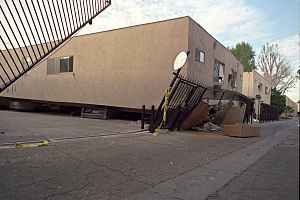
The columns that support dingbat-style buildings can be weak during earthquakes. These are called "soft-story buildings." For example, during the 1994 Northridge earthquake in Los Angeles, about 200 soft-story apartment buildings collapsed.
To make these buildings safer, their overhanging parts need to be made stronger. This can be done by adding stronger support materials, like steel beams or thick wooden columns. Many cities, including Los Angeles, now require owners of these buildings to make these safety upgrades.
Dingbats in Movies and Art
Dingbats have appeared in art and movies. Photographer Lesley Marlene Siegel has taken over 2,300 pictures of dingbats since the 1990s. Another artist, Clive Piercy, published a book of 480 dingbat photos.
In the 1998 movie The Slums of Beverly Hills, a teenage character named Viv talks about dingbats. She says her family is always moving from one dingbat to another. She describes them as "Two-story apartment buildings featuring cheap rents and fancy names that promise the good life, but never deliver."
Gallery


